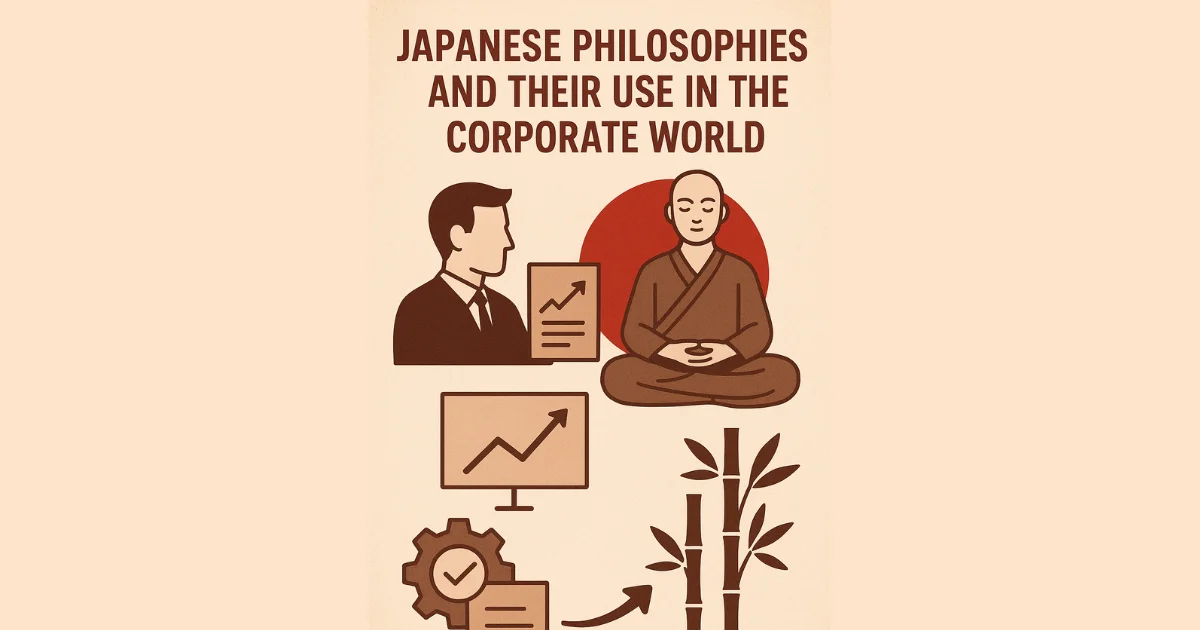People often say that Japanese business concept is a mix of old cultural ideas and new ideas that came out of World War II. From samurai-era ethics to Zen-influenced mindfulness, and from village-level consensus practices to the industrial engineering breakthroughs at Toyota, these philosophies have shaped not only Japan’s domestic corporate culture but also many successful management methods worldwide. This article traces several influential Japanese philosophies — what they are, where they came from, how they were institutionalized in business, and how effective they’ve proven in modern corporate use.
Overview: Why Japanese philosophies matter in business
Two features make Japanese philosophies particularly useful for managers and organizations everywhere: (1) they offer both ethical/cultural frameworks (e.g., Bushidō, Zen, ikigai) that shape human behavior and motivation, and (2) they provide concrete operational practices (e.g., kaizen, 5S, nemawashi) that structure everyday work and decision-making. Many multinational corporations research and implement them because of the way they combine value systems with practice-oriented tools, which helps businesses integrate their long-term purpose with day-to-day implementation. Major Japanese industrial innovations, especially the Toyota Production System (TPS), provided a practical laboratory where cultural insights were converted into scalable management techniques that spread worldwide.
Kaizen — continuous improvement, from idea to global method
What it is
Kaizen (改善) literally means “change for the better.” At its core is the belief that small, continual improvements across processes and behaviors compound into major gains over time. Kaizen is both a mindset (everyone can and should propose improvements) and a method (structured problem-solving, PDCA cycles, kaizen events, suggestion systems).
Where it came from
Kaizen’s modern business application grew after World War II as Japanese industry rebuilt. Influences include American quality theory (Shewhart, Deming) and Japanese shop-floor practices; Toyota is the most visible practitioner, embedding continuous improvement into the Toyota Production System (TPS). The company institutionalized small, consistent improvements as a way to reduce waste and strengthen quality.
Use in corporations
Kaizen shows up as suggestion boxes, daily huddles, kaizen events (“blitzes”), and formal problem-solving routines (root cause analysis, PDCA). Unlike one-off improvement projects, kaizen emphasizes velocity of tiny changes, low investment, and broad participation — which helps build employee ownership and rapid learning.
Effectiveness
Strengths:
- Builds continuous learning and morale because employees see their ideas implemented.
- Produces cumulative operational gains with low capital outlay.
- Fits well with lean/just-in-time models to reduce inventory and cycle time.
Limits:
- Gains can plateau without strategic alignment; incremental changes may not solve systemic problems.
- Overemphasis on small improvements can distract from necessary transformational investments.
- Requires cultural support (psychological safety, respect for employees) to surface problems honestly.
Kaizen works very well for operational excellence when it is combined with leadership direction and ways to deal with bigger problems that can’t be fixed with small changes.
The Toyota Production System & Lean thinking — systematizing efficiency
What it is
The Toyota Production System (TPS) is a socio-technical system combining Just-In-Time production, jidoka (automation with a human touch), visual controls (e.g., kanban), and relentless waste reduction. TPS inspired “lean” thinking — a broader management philosophy focused on maximizing customer value while minimizing waste.
Origins
Developed by Taiichi Ohno, Eiji Toyoda, and others across the mid-20th century, TPS was a response to resource scarcity and the need for flexibility. Rather than copy mass production, Toyota redesigned processes to produce only what was needed, when it was needed, and to highlight abnormalities for immediate correction.
Implementation in companies
Lean tools (value stream mapping, 5S, kanban, SMED, standardized work) are widely used across manufacturing and services. Firms outside manufacturing — healthcare, software, public sector — have adapted lean principles to reduce lead times, improve quality, and enhance customer experience. Training, leadership commitment, and cross-functional problem-solving are key implementation requirements.
Effectiveness
- Proven reductions in lead time, inventory, and defects in many settings.
- When applied superficially (toolbox approach), benefits are limited; transformative impact requires cultural change and management system redesign.
- Lean’s emphasis on respect for people and problem-solving can boost engagement — but only if adopted authentically rather than as headcount or cost-cutting shorthand.
Lean/TPS is among the most empirically validated operational philosophies in modern management — its successes at Toyota and later in Western companies helped make it one of the most influential business ideas of the 20th century.
5S — orderliness as the foundation of reliability
inspection routines, document standards, and build discipline to sustain them. It’s used in factories, offices, labs, and hospitals to reduce search time, improve safety, and create a foundation for process control.
Effectiveness
Simple yet effective: better ergonomics, fewer mistakes caused by misplaced instruments, and a workplace that makes process problems easy to see. The hard part is keeping up the discipline. Without leadership support and employee ownership, 5S can turn into just seeming clean, which hides fundamental problems with the process.
Nemawashi — informal consensus and change management
What it is
Nemawashi (根回し) literally means “turning the roots.” In business, it describes the practice of quietly laying the groundwork for decisions by consulting stakeholders one-on-one before a formal meeting. Nemawashi builds consensus, surfaces objections early, and helps avoid public conflict.
Why it matters
Nemawashi is a cultural way to make changes in an organization go more smoothly. It respects the hierarchy and the need to avoid public embarrassment, but it also makes sure that most people are already on the same page when a decision is made. People who aren’t involved may think it’s sluggish or unclear, but for people who are, it keeps things running smoothly and lowers the chance of having to do things over.
Effectiveness
Strengths:
- Reduces resistance to change by addressing concerns privately.
- Minimizes time wasted in formal meetings where positions are entrenched.
Limits:
- Can feel exclusive to those not part of networked relationships.
- May slow rapid innovation where fast, bold decisions are needed.
- Risk of creating echo chambers if leaders only seek agreement rather than challenge.
Nemawashi is very effective in contexts that prize consensus and stable relationships; in hyper-agile environments, a balance between rapid experiments and prior consultation is required.
Hansei — the disciplined art of reflection
What it is
Hansei (反省) means self-reflection or introspection. In business, it’s the practice of reviewing outcomes (especially failures), acknowledging responsibility, and planning concrete countermeasures so the same mistake won’t recur. It’s often formalized in post-mortem meetings or after-action reviews.
Application
Hansei encourages accountability and continuous learning. Teams hold structured reflection sessions to ask: what went well, what didn’t, why, and what will we change? The cultural humility embedded in hansei — admitting error and focusing on remedy — helps organizations avoid repeating mistakes.
Effectiveness
Hansei works well with groups that want to learn and be very reliable. For hansei to work, people need to feel safe. If they are afraid of punishment, hansei becomes performative. Hansei, when done honestly, cuts down on the number of times problems happen and makes it easier to share knowledge.
Bushidō — samurai ethics and corporate values
What it is
Bushidō (武士道) refers to the code of the samurai: honor, loyalty, courage, frugality, self-discipline, and respect. While its classical form belongs to pre-modern Japan, aspects of Bushidō have percolated into modern Japanese corporate culture — notably loyalty to the group, dedication to mastery, and emphasis on duty.
Corporate manifestations
- Strong employer loyalty (traditionally long tenure).
- High standards of workmanship and pride in one’s work.
- Formal ceremonies and etiquette that uphold a hierarchy.
Effectiveness and criticisms
Bushidō-inspired values can make people more reliable, skilled, and unified as a company, but they can also make hierarchies more rigid, discourage dissent, and slow down the process of adapting. As Japanese firms globalize, many blend the constructive elements (discipline, pride) with more open leadership styles to encourage innovation.
Zen and mindfulness — focusing attention to improve judgment
What it is
Zen Buddhism stresses direct experience, being present in the moment, simplicity, and letting go of the ego. In business world, Zen ideas have been turned into mindfulness, purposeful focus, simple design, and a preference for clarity over unnecessary complexity.
Business uses
- Mindfulness programs to reduce stress and improve concentration.
- Design philosophies that value simplicity (for example, clear user interfaces and elegant engineering).
- Management decisions that value calm deliberation and situational clarity over reactive urgency.
Effectiveness
Practices based on mindfulness and Zen can help you make better decisions, avoid burnout, and be more creative. The goal is real integration (practices that are part of daily life) instead of surface advantages that don’t help with workload or systemic pressures.
Ikigai — aligning purpose and work
What it is
Ikigai (生き甲斐) roughly means “reason for being.” Its modern popularity comes from the idea that connecting what you love, what you’re good at, what society needs, and what you can be paid for leads to fulfilling work. Businesses have used ikigai to reframe employee engagement, career paths, and employer branding.
Use in corporations
Ikigai-inspired programs emphasize purpose-driven roles, job crafting, and internal mobility that let employees pursue meaning while contributing to business outcomes. It’s often used in talent retention and employer value propositions.
Effectiveness
Ikigai is important in economies based on knowledge and service where intrinsic motivation is important. It helps bring in and keep employees who want a sense of purpose, but it needs to be backed up by real career growth and fair pay; otherwise, ikigai talk sounds empty.
How these philosophies work together in practice
In progressive Japanese companies, these philosophies are not separate fads but complementary layers:
- Values and motivation (Bushidō, ikigai, Zen) shape why people show up and how they behave.
- Decision and relationship norms (nemawashi, hansei) shape how decisions are made and learning occurs.
- Operational routines and systems (kaizen, TPS, 5S) translate values and norms into day-to-day practice.
This stack—values → norms → routines—is strong because it connects cultural identity with measurable results like better quality, shorter lead times, and constant innovation. The classic example of cultural norms (respect for people, problem-solving) and production techniques (JIT, kanban, jidoka) working together is Toyota.
Global adoption — translation and misinterpretation
Japanese methods have been widely exported, but adoption quality varies.
Success factors
- Deep leadership commitment: companies that say they will see long-term gains usually build practices into their management systems.
- Training and problem-solving capacity: workforce capability to analyze and solve root causes matters.
- Cultural adaptation: successful implementations don’t just copy rituals word for word; they adapt principles to fit local situations.
Common failures
- Toolbox approach: picking a few lean tools without systemic change seldom delivers sustained gains.
- Culture mismatch: assuming that practices like nemawashi will work identically in low-context, high-individualism cultures can cause friction.
Too much focus on cutting costs: using kaizen just to cut jobs hurts trust and stops people from getting better all the time.
Measuring effectiveness — what the evidence shows
Empirical evidence and case studies suggest the following:
- Operational metrics: Companies that strictly follow TPS/lean usually see improvements in lead time, defect rates, and inventory turnover. There is a lot of evidence that these gains happen in manufacturing and more and more in services.
- Employee engagement: Kaizen and other participatory methods can get employees more involved if leaders listen to their ideas and give them training.
- Quality of decision-making: Techniques like nemawashi and hansei aid in learning and adoption, they may cause decision-making paradox unless there are rapid experimentation methods to effectively utilize it.
- Sustainability: long-term benefits need to be reinforced all the time; short pilot programs that don’t change the system tend to fade away.
When applied as integrated management systems with leadership support and localized adaptations, these philosophies work well. Superficial or opportunistic adoption produces mixed or transient results.
Contemporary challenges and adaptations
Digital transformation and agile methods
Organizations nowadays are torn between traditional consensus and cautious planning (nemawashi, hansei) and the speed and experimentation that agile software development encourages. To solve this problem, many firms use smaller, cross-functional teams that perform regular retrospectives (similar to hansei) while still getting input from a wider range of people when making strategic changes.
Global workforces
Multinational companies must translate Japanese norms for diverse cultures. This requires explicit translation of practices (e.g., make nemawashi visible by scheduling pre-meetings) and training local leaders in the underlying intent.
Wellbeing and work styles
Longer hours and lifetime jobs, which are sometimes based on older business practices, are being balanced out. People are using ikigai, Zen, and mindfulness to change the way they think about work so that it is more meaningful and less exploitative. However, real change needs more than just words; it needs structural changes like flexible hours and job redesign.
Practical guide: how to borrow Japanese philosophies wisely
If you’re a manager interested in applying these ideas, consider this pragmatic sequence:
- Start with purpose — Make the organization’s mission (ikigai) clear so that improvement initiatives are in line with important objectives.
- Build reflection routines — To learn fast institutionalize hansei/retrospectives following projects.
- Organize the workplace — Utilize 5S as a low-risk measure to generate momentum and visibility.
- Introduce kaizen experiments — allow workers to run short cycles of improvement (PDCA) and give rewards for suggestions that are put into action.
- Create consensus pathways — adapt nemawashi: To avoid stalling, time-box the stakeholder pre-work for significant changes.
- Measure and scale — Keep an eye on lead time, quality, and engagement; make sure that what works is the same across the board, and put money into skills.
- Mind the culture fit — explain the intent behind practices, not just the rituals, so local teams can adapt them thoughtfully.
This order keeps the ideas behind the philosophies alive while making sure they work.
Case snapshots (illustrative)
- Toyota: Longstanding embodiment of TPS, kaizen, jidoka; credited with dramatic quality and efficiency gains that made it a global leader. Toyota’s model shows how powerful it is to combine cultural norms with technical systems.
- Healthcare & services: Hospitals implementing lean value-stream thinking and standardized work to cut down on errors and wait times for patients.
- Tech firms: Some software teams use kanban and retrospectives (hansei) to improve throughput and learning blending agile with lean concepts.
Critiques and cautions
- Romanticization: Western popularizations occasionally romanticize ideas (e.g., ikigai as a one-page solution to life’s problems). When cultural depth is reduced to a buzzword, nuance is lost.
- Rigidity: Elements like Bushidō can be misused to justify hierarchical or inflexible practices that stifle dissent and innovation.
- Ethical misuse: If lean and kaizen are not counterbalanced with respect for people and fair labor practices, they can be used as a weapon to apply constant pressure on productivity.
Good leadership mitigates these risks by combining operational rigor with human-centered policies.
Future outlook — evolving relevance
Japanese management philosophies are still very useful because they deal with problems that always come up in organizations, like how to learn from mistakes, how to align purpose and process, and how to get people to work together. Their next wave of relevance will likely be in hybrid forms:
- Lean principles informing AI and data-driven process improvement.
- Hansei-style reflection embedded in continuous deployment and model monitoring for AI systems.
- Ikigai and mindfulness helping organizations manage employee wellbeing in remote/hybrid work.
The main point is that strong ideologies balance human purpose with strict practice. They can be used with new technologies and work patterns while still fixing the old problems of waste, error, and disengagement.
Conclusion
Japanese philosophies — from kaizen and TPS to hansei, nemawashi, Bushidō, Zen, 5S, and ikigai — provide a rich toolkit mixing ethical orientation with practical routines. They have proven especially powerful when integrated: values inform norms, norms direct routines, and routines produce measurable outcomes. That integrated system is why Toyota’s model reshaped modern management and why other organizations (in manufacturing, services, healthcare, and beyond) continue to adapt these ideas.
Authenticity is key to effectiveness: leaders need to be clear about their goals, teach others how to do things, and change how things are done to fit the needs of the area. When used with care, these ideas cut down on waste, improve quality, boost learning, and link people’s work to something more than just their jobs.
Frequently Asked Questions about
1. What are the most important Japanese philosophies used in the corporate world?
The Toyota Production System (TPS), Lean thinking, Nemawashi (informal consensus-building), Hansei (structured reflection), Bushidō (samurai ethics), Zen and mindfulness, Ikigai (purpose-driven work), and Kaizen (continuous improvement) are some of the most influential philosophies.
2. What is Kaizen, and how does it work in organizations?
Kaizen, which means “change for the better,” focuses on everyone in the organization making small, ongoing improvements. Companies use suggestion systems, daily problem-solving, and kaizen workshops to put it into action. These small changes add up over time to make things much better in terms of quality and efficiency.
3. How does the Toyota Production System (TPS) differ from Kaizen?
Kaizen is a way of thinking and doing things that focuses on making things better all the time. TPS, on the other hand, is a complete system for managing and producing things that includes kaizen, Just-In-Time, jidoka (automation with human oversight), and getting rid of waste. Later, TPS inspired Lean thinking all over the world.
4. What is 5S, and why is it important?
Sort, Set in Order, Shine, Standardize, and Sustain are the five S’s. It is a method of workplace organization that guarantees efficiency, safety, and cleanliness. 5S lays a solid basis for more complex lean techniques and aids in identifying process issues.
Strategic Supply Chain Leader | Finance Strategist | SAP MM Expert | US Tax & Accounts Outsourcing | Driving Organizational Excellence Through Innovation




